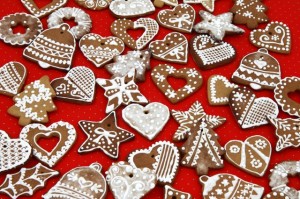 Although the Czech lands do not have very rich tradition in confectionery, not as much as in bakery, it provides a range variety of adopted and modified delicacies which will satisfy everyone who loves sweets.
Although the Czech lands do not have very rich tradition in confectionery, not as much as in bakery, it provides a range variety of adopted and modified delicacies which will satisfy everyone who loves sweets.
Origins of Czech confectionery
One of the first Czech mentions of sweets manufacture and mongering is speaking about producers of gingerbread and sweets for which they used honey, sugar and flour and then they sold their confectionery, a contemporary parallel to hard candy, in the streets. A similar range of sweets was also sold in apothecaries. The first confectioner mentioned in writing is most likely Mates who was the first street seller in 16th century in Prague. Making of confectionery was very popular in the times of Rudolf II (1576 – 1611) when, following the French trends, people made pastry creations such as peacocks, flowers baskets and other decorative candy. It was not earlier than in the 17th century when cakes, biscuits and other pastry were introduced to the Czech lands. It’s also the first time people tasted small candies and sweet jellies.
Development of Czech confectionery to the present
The gingerbread gained large popularity across the country. The Czech word for the Czech version of gingerbread is ‘Perník’ which came from the word ‘peprník’ which is derived from the Czech word for pepper. Ginger, along with other ingredients like milk, egg, cinnamon, clove, cardamom or mace were added to the recipe later. Another quite favourite dainty is marzipan. This sweet candy was spread across Europe from the oriental countries and can have many forms, decorations, shapes and colours. Marzipan figures are present in every Czech sweet shop. The Czechs also like custards and crèmes. In combination with various icings you can find it in cream rolls, cream puffs, walnut rolls with chocolate cream and many other combinations. Fruit in jelly is also quite a common filling in various butter cupcakes with whipped cream.
 The best time for confectionery then comes with Christmas. The Christmas family top would certainly include the vanilla rolls with butter and walnut, a nice small brittle which almost melts in the mouth. Another kind of sweet you would typically find on the Christmas table is small gingerbreads decorated with lemon icing. These small crunchy sweets take shape of animals and fairy tale characters, or little cottages, Christmas trees, angels and other related motives. The top third is completed by Linzer cookies, which are among many types adopted from the surrounding countries, yet are considered as traditional as most of the others.
The best time for confectionery then comes with Christmas. The Christmas family top would certainly include the vanilla rolls with butter and walnut, a nice small brittle which almost melts in the mouth. Another kind of sweet you would typically find on the Christmas table is small gingerbreads decorated with lemon icing. These small crunchy sweets take shape of animals and fairy tale characters, or little cottages, Christmas trees, angels and other related motives. The top third is completed by Linzer cookies, which are among many types adopted from the surrounding countries, yet are considered as traditional as most of the others.
Last but not least, it is certainly worth pointing out that Czech have learned, from countries like Austria and France, to perform art in form of cakes which come really in as many forms as there are. The ingredients are rich and decorations beautiful. In each good café you can get cake as good as in any country with tradition in bakery and confectionery.
So although there is a great share of foreign influence, each sweet tooth will meet its needs in the plentiful range offered in good Czech confectioneries, renowned cafés and restaurants.
 Although the Czech lands do not have very rich tradition in confectionery, not as much as in bakery, it provides a range variety of adopted and modified delicacies which will satisfy everyone who loves sweets.
Although the Czech lands do not have very rich tradition in confectionery, not as much as in bakery, it provides a range variety of adopted and modified delicacies which will satisfy everyone who loves sweets. The best time for confectionery then comes with Christmas. The Christmas family top would certainly include the vanilla rolls with butter and walnut, a nice small brittle which almost melts in the mouth. Another kind of sweet you would typically find on the Christmas table is small gingerbreads decorated with lemon icing. These small crunchy sweets take shape of animals and fairy tale characters, or little cottages, Christmas trees, angels and other related motives. The top third is completed by Linzer cookies, which are among many types adopted from the surrounding countries, yet are considered as traditional as most of the others.
The best time for confectionery then comes with Christmas. The Christmas family top would certainly include the vanilla rolls with butter and walnut, a nice small brittle which almost melts in the mouth. Another kind of sweet you would typically find on the Christmas table is small gingerbreads decorated with lemon icing. These small crunchy sweets take shape of animals and fairy tale characters, or little cottages, Christmas trees, angels and other related motives. The top third is completed by Linzer cookies, which are among many types adopted from the surrounding countries, yet are considered as traditional as most of the others.